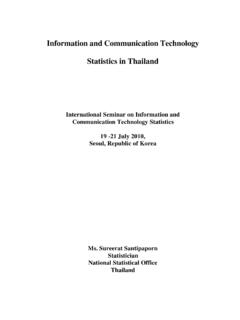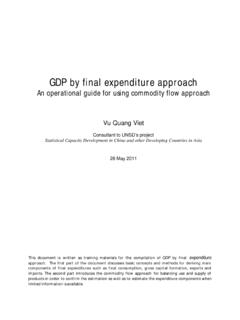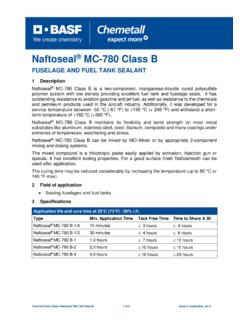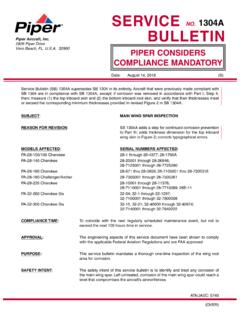Transcription of Lithium-ion Batteries for Electric Vehicles
1 Lithium-ion Batteries for Electric Vehicles : THE VALUE CHAIN October 5, 2010 Marcy Lowe, Saori Tokuoka, Tali Trigg and Gary Gereffi Contributing CGGC researcher: Ansam Abayechi Lithium-ion Batteries for Hybrid and All- Electric Vehicles : the Value Chain 2 This research was prepared on behalf of Environmental Defense Fund: The authors would like to thank our anonymous interviewees and reviewers, who gave generously of their time and expertise. We would also like to thank Jackie Roberts of EDF for comments on early drafts. None of the opinions or comments expressed in this study are endorsed by the companies mentioned or individuals interviewed. Errors of fact or interpretation remain exclusively with the authors. We welcome comments and suggestions. The lead author can be contacted at List of Abbreviations ANL Argonne National Laboratory ARRA American Recovery and Reinvestment Act BEV Battery Electric Vehicle CGGC Center on Globalization, Governance & Competitiveness CNT Carbon nano-tubes DOE Department of Energy EPA Environmental Protection Agency EV Electric Vehicle JV Joint Venture LBNL Lawrence Berkeley National Laboratory METI Ministry of Economy, Trade And Industry in Japan NaS Sodium-Sulfur (battery) NEDO New Energy and Industrial Technology Development Organization (Japan)
2 Ni-Cd Nickel Cadmium Ni-MH Nickel Metal Hydride NREL National Renewable Energy Laboratory ORNL Oakridge National Laboratory PHEV Plug-in Hybrid Electric Vehicle R&D Research and Development SNL Sandia National Laboratory UPS Uninterruptible Power Supply V2G Vehicle to Grid Cover photo courtesy of Argonne National Laboratory October 5, 2010. Center on Globalization, Governance & Competitiveness Duke University Lithium-ion Batteries for Hybrid and All- Electric Vehicles : the Value Chain 3 Table of contents Executive summary .. 6 Introduction .. 10 Technology 11 Advantages of Lithium-ion Batteries for vehicle use .. 12 How does a Lithium-ion battery work? .. 14 Technology and cost challenges .. 16 Global 18 National policies.
3 22 Patents and R&D .. 23 Lead battery pack firms .. 26 value chain .. 29 What goes into a battery? .. 29 value chain, by segment .. 35 Cost breakdown .. 41 manufacturing .. 43 Firm-level data .. 44 Location-level data .. 47 Startup firms .. 48 manufacturing jobs .. 52 Future of the supply base .. 54 strengths and opportunities .. 54 weaknesses and threats .. 55 Capacity and demand .. 56 Future strategies .. 59 Synergies with other clean energy technologies .. 62 Energy storage to increase penetration of solar and wind power .. 63 Decentralized and centralized energy storage .. 63 Nanotechnology .. 65 Fuel cells, advanced electronics, and biotechnology .. 66 Conclusion .. 69 References cited .. 70 Lithium-ion Batteries for Hybrid and All- Electric Vehicles : the Value Chain 4 List of figures Figure 1. Battery performance requirement by vehicle application.
4 12 Figure 2. Power (acceleration) and energy (range) by battery type .. 13 Figure 3. Advances in energy density of selected battery types, by year .. 14 Figure 4. Discharging mechanism of a Lithium-ion battery .. 15 Figure 5. Lithium-ion battery cell, module and 16 Figure 6. Global Lithium-ion battery market share, by country and by firm .. 18 Figure 7. Global employment in the Lithium-ion battery industry .. 19 Figure 8. Lithium-ion cell & battery manufacturing, market share, by country .. 21 Figure 9. Government funding of battery technology development for Vehicles , United States and Japan, 2002-2009 .. 23 Figure 10. Patents and research papers related to Lithium-ion Batteries 1998 2007, by 24 Figure 11. Production structure of the Lithium-ion battery industry .. 29 Figure 12. Structure of a cylindrical Lithium-ion battery .. 32 Figure 13. Structure of a stack Lithium-ion battery.
5 32 Figure 14. Value chain of Lithium-ion Batteries for Vehicles .. 33 Figure 15. Global value chain of Lithium-ion Batteries for Vehicles , with major global players and players with current and planned facilities (not exhaustive) .. 34 Figure 16. Alliances and joint ventures between battery firms and automakers .. 39 Figure 17. national rechargeable battery projects and players .. 41 Figure 18. Lithium-ion battery-relevant manufacturing and R&D locations .. 48 Figure 19. Industry structure of conventional combustion Vehicles vs. EVs .. 52 Figure 20. Global vehicle forecast, 2010-2020 .. 57 Figure 21. Forecast of production capacity for cars using Lithium-ion Batteries , 2015 .. 59 Lithium-ion Batteries for Hybrid and All- Electric Vehicles : the Value Chain 5 Figure 22. Lithium-ion battery power density and energy density required by 2020, by application .. 62 Figure 23.
6 Lithium-ion battery road map and nanotechnology .. 65 Figure 24. Carbon nanotube technology: possible applications .. 67 List of tables Table 1. Technical performance by existing battery type .. 13 Table 2. Lithium-ion battery components, functions, and main materials .. 15 Table 3. Top 10 applicants for Lithium-ion battery patents in the United States .. 25 Table 4. Top 30 authors of academic research papers related to Lithium-ion Batteries .. 25 Table 5. Key players production capacity for Lithium-ion Batteries : Europe, Japan, South Korea, United States .. 28 Table 6. Four major types of cathodes for Lithium-ion Batteries : energy density, pros and cons, and manufacturers .. 30 Table 7. Lithium-ion battery cost breakdown .. 42 Table 8. ARRA grants to Lithium-ion battery manufacturers and material suppliers .. 43 Table 9. Lithium-ion battery-related firms with current and planned manufacturing, assembly and R&D locations: firm-level data.
7 45 Table 10. startup firms in the Lithium-ion battery industry .. 50 Table 11. Outlook for Lithium-ion battery demand, capacity, and use, EV-equivalent in thousands of units .. 58 Table 12. Strategy matrix of strengths, weaknesses, opportunities, and threats - Lithium-ion battery supply chain .. 61 Table 13. Major players in CNT manufacturing and R&D .. 68 Lithium-ion Batteries for Hybrid and All- Electric Vehicles : the Value Chain 6 Executive summary The global motor vehicle industry is rapidly steering away from the internal combustion engine. Electric Vehicles are increasingly attractive for their potential to reduce greenhouse gases and decrease dependence on oil. By 2020, more than half of new vehicle sales will likely consist of hybrid- Electric , plug-in hybrid, and all- Electric models. For automakers, the key to this huge shift will be Lithium-ion Batteries .
8 While 96% of all hybrids available on the world market today run on nickel metal hydride Batteries , within 10 years, 70% of hybrids, and 100% of plug-in hybrid and all- Electric Vehicles , are expected to run on Lithium-ion (Deutsche Bank, 2009). If the United States is to compete in the future auto industry, it will need to be a major player in Lithium-ion Batteries . Today s Lithium-ion Batteries , found in nearly all consumer electronics and made almost exclusively in Asia, will require additional technological advances before they can be applied widely to tomorrow s Electric Vehicles . Still needed are improvements in safety and durability, along with cost reductions. The current cost of Lithium-ion Batteries for vehicle applications is four to eight times that of lead acid Batteries , and one to four times that of nickel metal hydride Batteries (Nishino, 2010). Although researchers at the University of Texas in Austin made crucial contributions to the development of the rechargeable Lithium-ion battery in the 1980s, firms at that time declined to pursue the industry, leaving it to better established electronics companies in Japan.
9 As a result, the United States for years had almost no presence in Lithium-ion Batteries . In the late 1990s, when Toyota raced ahead with the first hybrid Vehicles , automakers belatedly learned the importance of acquiring relevant battery manufacturing capability. The United States appears committed to learning from past experience and seizing the opportunity to be a leader in Lithium-ion Batteries for Vehicles . firms have several advantages in Lithium-ion Batteries , including research capacity, a well-established domestic automotive industry, a large market for Vehicles , and the support of government policies. According to announced capacity expansions, the United States is on track to achieve a 40%-share of global capacity to produce Lithium-ion Batteries for Vehicles by 2015 (DOE, 2010). Funds from the American Reinvestment and Recovery Act of 2009 have jumpstarted the industry from only two battery pack plants pre-ARRA, to 30 planned sites, all playing key roles across the value chain, including materials, components, and production of cells and battery packs.
10 Lithium-ion Batteries for Hybrid and All- Electric Vehicles : the Value Chain 7 This report maps out the value chain of Lithium-ion Batteries for hybrid and all- Electric Vehicles and identifies the manufacturing that takes place in the United States. Our analysis yields the following key findings about the value chain: At least 50 firms are involved to date, with 119 locations in 27 states performing manufacturing and research and development (R&D).1 California and Michigan have the most activity, with 28 and 13 sites, respectively. Other geographic areas of concentration include the Northeast Atlantic (9 sites), Greater Chicago area (8) and the Carolinas (7). In addition to these established firms, at least 18 startups are entering the industry. activity is concentrated in Tier 1 (cell/battery pack assembly), highlighting the need for increased domestic manufacture of cells and cell components.
















